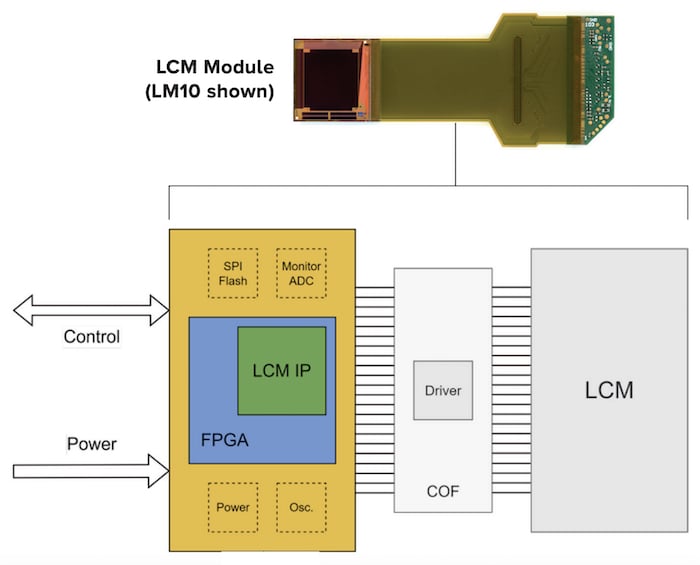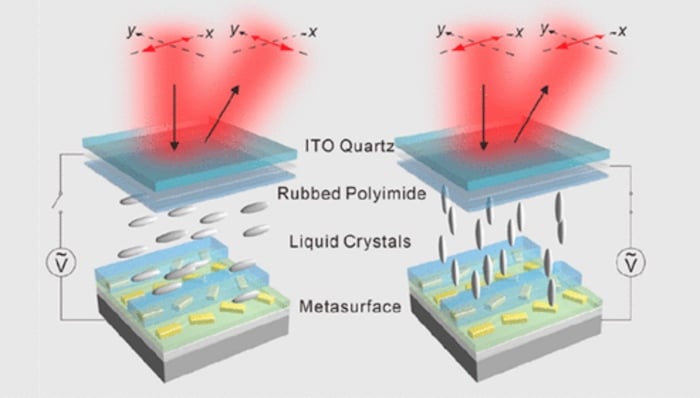Lumotive Releases First Commercial Optical Beam-Steering Chip for LiDAR
All About Circuits received exclusive details about Lumotive’s new LM10 chip, the first commercial optical beam-steering chip designed to make optical 3D sensing as mainstream as cameras.
LiDAR technology has gained significant momentum in the past year with a sharp incline in robotics and autonomous vehicle innovation. Still, many limitations, such as reliability, ease of use, and size, significantly hinder the adoption of the technology.
To address these issues, Lumotive today announced its new LM10 solution, the industry’s first commercially available optical beam-steering semiconductor. With the software-definable optical metasurface chip, Lumotive believes it can democratize LiDAR and enhance the technology for a host of applications, from object tracking to autonomous navigation.

Lumotive's Light Control Metasurface (LCM) digital beam-steering chip. Image (modified) used courtesy of Lumotive
The First Light Control Metasurface (LCM) Technology
Developed over eight years of research and development, the Lumotive LM10 chip uses Light Control Metasurface (LCM) technology for optical 3D sensing and LiDAR applications. The chip is enclosed in a compact 60 mm x 24 mm x 3.5 mm package and offers an active optical aperture of 9 mm x 10 mm. The LM10 is also compatible with both Vertical-Cavity Surface-Emitting Lasers (VCSELs) and edge emitters.

The LM10 module. Image used courtesy of Lumotive
The LM10 includes “true solid-state, zero-inertia” beam-steering technology. This provides a wide field of view (FOV) of 160 degrees, advantageous for broad environmental scanning, and an angular step size of 0.39 degrees for relatively fine control over beam direction. Lumotive claims the chip has a response time of 100 microseconds and provides wavelength options of 905 and 940 nm. The device can operate between -20°C to +85°C for a lifetime of more than 10,000 hours.
For ease of use and system integration, an integrated LCM control module supports the chip, featuring all required interfaces and logic to drive the LCM. The chip also offers built-in support for pre-validated FPGA bitstreams and FPGA/ASIC soft IP.
What Are Dynamic Optical Metasurfaces?
Dynamic optical metasurfaces are engineered materials with subwavelength features that can manipulate electromagnetic waves in a highly controlled manner. Unlike traditional optical elements, which rely on bulk properties to affect light, metasurfaces operate at the interface level, making them conducive for more compact and efficient optical systems. Metasurfaces can also be dynamically tuned to change their properties in real-time, enabling a wide range of functionalities such as beam steering, focusing, and polarization control.

An electrically tunable optical metasurface. Image used courtesy of Nano Letters via ACS Publications
Dynamic optical metasurfaces offer several advantages in LiDAR systems. Traditional LiDAR systems often use mechanical methods for beam steering, which involves physically rotating mirrors or other components. This mechanical approach limits speed, reliability, and form factor. Dynamic optical metasurfaces, on the other hand, can steer beams electronically without any moving parts. For example, a LiDAR system equipped with a dynamic optical metasurface can quickly scan an environment by electronically steering the laser beam across various angles and distances, capturing high-resolution, three-dimensional data.
The solid-state nature of metasurfaces increases system reliability by eliminating mechanical wear and tear. Their electronic control of beam direction also enables faster data acquisition—a crucial feature in applications like autonomous vehicles that require real-time decision-making. Finally, the compact form factor of metasurfaces allows engineers to design more streamlined and lightweight LiDAR systems.
Availability of the LM10 and M30 Reference Design
With Lumotive’s launch of the LM10 today, the company hopes customers can more easily overcome the limitations of conventional LiDAR systems. Along with the LM10, Lumotive has also released a LiDAR sensor reference design built around the new chip to help designers bring optical 3D sensing to market faster than before.







